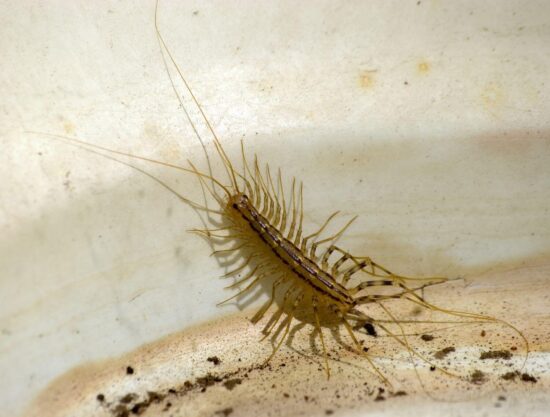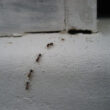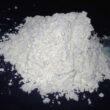Ever seen a centipede skittering across your floor and wondered what those many-legged creatures are looking for? These fascinating predators have been around for over 400 million years, and they’ve gotten really good at one thing: hunting. With more than 3,000 species worldwide, centipedes are some of nature’s most effective pest controllers. Understanding what centipedes eat can help you appreciate why these creatures might actually be helping your home stay bug-free.
Centipedes are completely carnivorous, which means they only eat meat. They use special venomous claws called forcipules to catch and kill their prey. These modified front legs work like deadly pincers, injecting venom that quickly paralyzes their victims. Most centipedes hunt at night when they can sneak up on unsuspecting prey in dark, damp places.
1. Common Household Insects and Pests
When people ask what centipedes eat inside homes, the answer might surprise them. House centipedes are like tiny exterminators that work for free. They love munching on cockroaches, silverfish, bed bugs, termites, and ants. These are exactly the kinds of bugs most homeowners want gone anyway.
House centipedes are especially good at catching these pests because they can move incredibly fast. Some can run over a foot per second, which makes them excellent hunters in tight spaces like behind appliances or in basement corners. They use their long legs to grab multiple small insects at once, then deliver venom through their forcipules.
- Pre-scented sticky traps for spiders, roaches, crickets & more
- Long-lasting, pet-safe, non-toxic formula with no odor
- Foldable design protects glue from dust and keeps traps hidden
- Made in the USA for year-round indoor pest control
The centipede diet when it comes to household pests makes them valuable allies. If you see centipedes in your home regularly, it usually means they’re finding plenty of food. This could indicate you have other pest problems that the centipedes are helping to control naturally.
2. Flying Insects (Moths, Flies, and Winged Prey)
Flying insects might seem like tough targets, but centipedes have mastered the art of catching them too. Moths, flies, gnats, and other winged creatures often land on walls or get trapped in corners where centipedes can reach them. Some larger centipede species can even jump or leap to catch flying prey.
The most impressive flying prey that centipedes catch has to be bats. Giant centipedes in caves have been observed climbing walls and hanging from cave ceilings to snatch bats right out of the air. These encounters show just how skilled these predators can be when they put their minds to it.
House centipedes particularly enjoy catching moths that get attracted to indoor lights. They wait patiently near light sources and pounce when moths come close enough. Their excellent reflexes and multiple legs give them a big advantage over slower-moving flying insects.
3. Soft-Bodied Garden Invertebrates
Garden centipedes have a feast waiting for them in the soil. They love eating earthworms, slugs, snails, and various soft-bodied larvae that live underground or in leaf litter. These creatures are perfect centipede food because they’re easy to catch and don’t have hard shells to deal with.
Earthworms are particularly popular in the centipede diet because they’re nutritious and abundant in most garden soils. Centipedes can sense the vibrations that worms make as they move through the dirt, making them easy to track down. A single centipede might eat several earthworms in one night if they’re available.
Slugs and snails also make excellent targets because they move slowly and can’t escape quickly when a centipede attacks. Garden centipedes help control these pests naturally, which means fewer damaged plants and vegetables for gardeners.
4. Other Arachnids (Spiders and Scorpions)
What centipedes eat often includes other predators like spiders and scorpions. This might seem risky, but centipedes are well-equipped for these challenging hunts. Their venom works quickly to paralyze spiders before they can fight back or escape.
House centipedes regularly hunt common house spiders, wolf spiders, and even some of the larger hunting spiders. They approach carefully and strike fast with their venomous forcipules. Once the spider is paralyzed, the centipede can safely consume its meal without worrying about getting bitten.
Larger centipede species in desert areas sometimes tackle scorpions, which are dangerous opponents with their own venomous stingers. These battles require skill and speed, but centipedes often win because they can attack from multiple angles with their many legs while delivering venom through their forcipules.
5. Insect Larvae and Pupae
Baby insects and pupae make easy meals for centipedes of all sizes. Fly larvae, beetle grubs, moth caterpillars, and other developing insects are soft and slow-moving, which makes them perfect targets. These larvae are often found in the same damp environments that centipedes prefer.
Soil-dwelling centipedes spend much of their time hunting for various types of larvae that live underground. Beetle grubs are especially common in garden soil and provide a good source of protein. Centipedes can detect these larvae through vibrations and chemical signals in the soil.
- Pre-scented sticky traps for spiders, roaches, crickets & more
- Long-lasting, pet-safe, non-toxic formula with no odor
- Foldable design protects glue from dust and keeps traps hidden
- Made in the USA for year-round indoor pest control
Pupae are even easier targets because they can’t move at all during their transformation stage. Centipedes will seek out chrysalises and cocoons to get an easy meal while insects are at their most vulnerable stage of development.
6. Small Vertebrates (When Available)
The most impressive part of what centipedes eat has to be small vertebrates. Giant centipedes like the Amazonian giant centipede can take down prey that seems impossibly large. These massive centipedes regularly catch and eat lizards, small frogs, baby birds, mice, and even small snakes.
The secret to their success is incredibly potent venom that can kill prey up to 15 times their own body weight in just 30 seconds. This venom blocks potassium channels in nerve cells, causing rapid paralysis and death in their victims. It’s one of the most effective venoms in the animal kingdom.
Some giant centipedes have been filmed catching bats in caves, grabbing them right out of mid-flight. Others hunt sleeping birds in their nests or catch small mammals that venture too close to centipede hiding spots. These hunts show just how versatile and dangerous large centipedes can be.
7. Other Centipedes (Cannibalistic Behavior)
Sometimes the centipede diet includes other centipedes. Cannibalism happens most often when food is scarce or when centipedes encounter injured members of their own species. Centipedes are naturally solitary and aggressive toward each other, so these encounters often end badly for the smaller or weaker individual.
Larger centipedes will attack smaller ones without hesitation, especially if they’re hungry. Injured or molting centipedes are particularly vulnerable because they can’t defend themselves properly. This cannibalistic behavior helps ensure that only the strongest centipedes survive in areas with limited food resources.
Even house centipedes sometimes eat each other, though this is less common since they usually have plenty of other prey available indoors. When it does happen, it’s typically because one centipede wandered into another’s territory during hunting.
8. Dead and Decaying Matter (Scavenging)
While centipedes prefer live prey, they’re not above scavenging when fresh food is hard to find. They’ll eat dead insects, decomposing worms, and other organic matter when hunting isn’t going well. This scavenging behavior helps them survive during tough times when live prey is scarce.
Centipedes also perform “raiding runs” where they sneak into spider webs to steal trapped insects. They’re careful to avoid getting stuck in the webs themselves while grabbing the paralyzed prey that spiders have caught. This clever behavior shows how adaptable these predators can be.
During winter months or dry seasons, scavenging becomes more important as many prey animals become less active or harder to find. Some centipedes will even eat rotting plant matter if absolutely necessary, though this isn’t their preferred food.
9. Aquatic and Semi-Aquatic Prey
Some centipede species live near water and have learned to hunt aquatic prey. These centipedes catch small crustaceans, water insects, and other creatures that live in or near streams, ponds, and wetlands. They’re excellent swimmers and can hold their breath for extended periods.
Coastal centipedes have developed the ability to hunt barnacles and other marine creatures in tidal pools. They wait for low tide and then scavenge among the rocks for stranded sea life. This specialized hunting shows how adaptable centipedes can be to different environments.
Even some house centipedes will hunt around sinks, bathtubs, and other damp areas where water-loving insects might gather. Drain flies, moisture-loving beetles, and other bathroom pests often fall victim to these opportunistic hunters.
10. Microscopic Prey (Nematodes and Mites)
The smallest items in what centipedes eat are tiny creatures like nematodes and mites. These microscopic animals might seem too small to bother with, but smaller centipede species rely on them as important food sources. Young centipedes especially depend on these tiny prey items as they grow.
Soil-dwelling centipedes encounter countless nematodes and mites as they move through dirt and leaf litter. While individual nematodes don’t provide much nutrition, centipedes can consume many of them quickly to get the energy they need.
Some centipede species have specialized in hunting these microscopic prey items, developing enhanced senses to detect them in soil and organic matter. This specialization allows them to fill an ecological niche that larger predators can’t access.
11. Seasonal and Emergency Food Sources
When regular prey becomes unavailable, centipedes get creative about what they eat. During harsh winters or dry seasons, some species will eat plant material, fungi, and other non-animal foods to survive. While this isn’t ideal nutrition for them, it helps them make it through tough times.
Centipedes that hibernate or become less active during winter build up fat reserves by eating heavily during warmer months. Some species actually change their body chemistry to store more energy for long periods without food.
In laboratory studies, starving centipedes have been observed eating fruits, vegetables, and other plant matter when no prey is available. This emergency feeding behavior shows how determined these creatures are to survive, even if it means temporarily changing their carnivorous habits.
12. Prey Stolen from Other Predators
One of the cleverest feeding behaviors involves stealing prey from other predators. Centipedes regularly raid spider webs to grab insects that are already caught and paralyzed. They’re careful to avoid the sticky parts of webs while making off with easy meals.
- Pre-scented sticky traps for spiders, roaches, crickets & more
- Long-lasting, pet-safe, non-toxic formula with no odor
- Foldable design protects glue from dust and keeps traps hidden
- Made in the USA for year-round indoor pest control
Some centipedes follow ant trails and pick off individual ants that have gotten separated from their groups. Others wait near bird feeding areas to catch insects that get stirred up by the birds’ activity. This opportunistic hunting strategy helps them find food with minimal effort.
Large centipedes sometimes steal kills from smaller predators like spiders or other centipedes. Their size and venom give them the ability to drive off smaller hunters and claim their prey as their own.
How to Keep Centipedes Away from Your Home
To prevent centipedes, focus on four key areas: eliminate their food sources by controlling other pest populations, reduce moisture with dehumidifiers and proper ventilation, seal cracks and entry points around your home, and remove hiding spots like leaf litter and clutter near your foundation.
Conclusion
Understanding what centipedes eat helps explain why these ancient predators have been so successful for millions of years. Their diverse centipede diet allows them to adapt to almost any environment where small prey animals exist. From tiny nematodes to mice 15 times their size, centipedes have proven they can hunt almost anything.
While they might look scary, centipedes are actually providing valuable pest control services in most homes and gardens. The next time you see one scurrying across your floor, remember that it’s probably on the hunt for insects you’d rather not have around anyway. These remarkable predators deserve respect for their hunting skills and their role in keeping pest populations under control.



